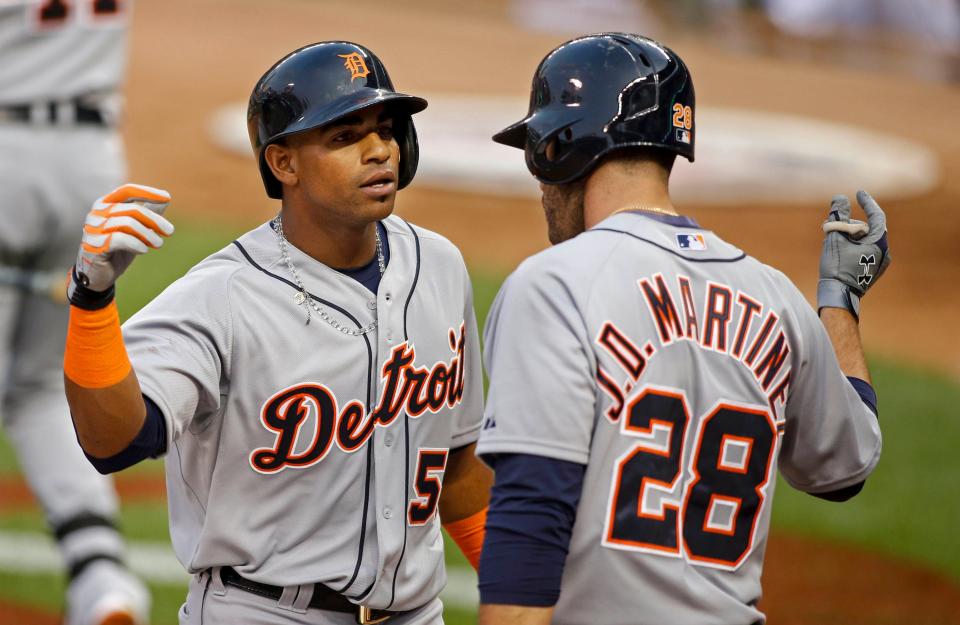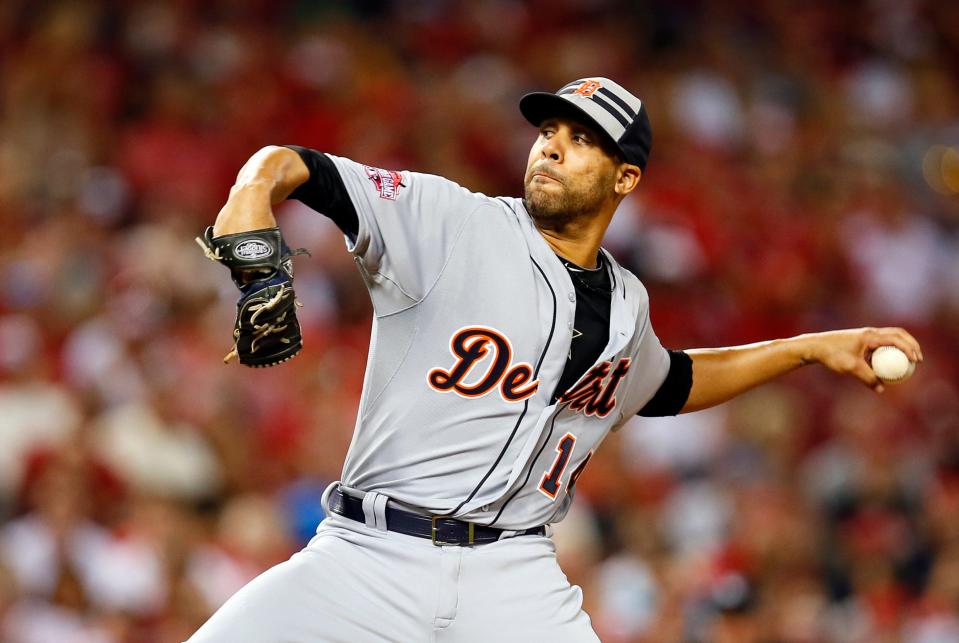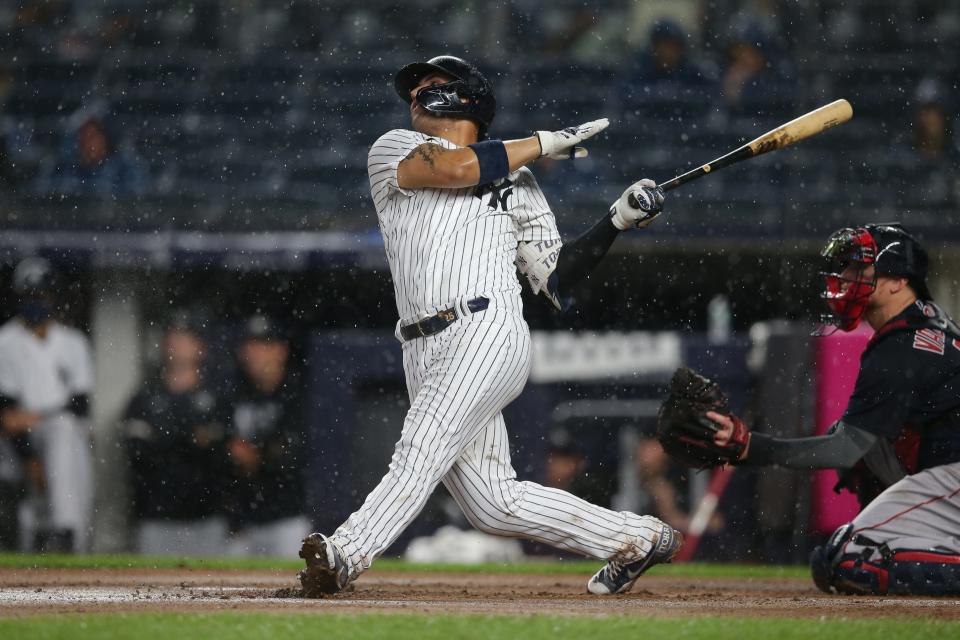Seller beware? Stars aren't fetching much at the MLB trade deadline
The trade deadline is one of baseball’s unofficial holidays, hyped by the league, fueled by its own media cottage industry and viewed as a source of hope for fans across generations.
Old heads might recall such heists like the Atlanta Braves acquiring John Smoltz from Detroit for Doyle Alexander, or the Houston Astros stealing their own Hall of Famer, Jeff Bagwell, from Boston for Larry Andersen.
Younger fans, accustomed to building their own franchises via video games or fantasy leagues, dream on incoming prospects and share with their elders a simple refrain: Better to trade a player than get nothing for them.
Yet increasingly, nothing is exactly what those clubs end up receiving.
A USA TODAY Sports analysis of 94 July trade-deadline deals from 2015 to 2019 that shipped 204 prospects from buyers to sellers confirms a strongly held feeling throughout the industry – that teams are holding their top prospects tighter than ever, making it exceedingly difficult to extract value for star players.
Of the 204 prospects dealt in that five-year span, just 38 have amassed at least 1.0 Wins Above Replacement for the acquiring team. The top five most valuable players traded in that time – pitchers Sean Manaea, Michael Fulmer, Zach Davies, Josh Hader and Matthew Boyd – were dealt in 2015, a year that proved anomalous for many reasons.
Since then, the lid on talent has tightened, cracking open only for the most desperate or overmatched executives.
“The hype has built up to where the return is hard to meet expectations,” Detroit Tigers general manager Al Avila, who has been a buyer, seller and holder at the deadline in the past decade, told USA TODAY Sports. “It’s not reality.”

Avila’s words are worth heeding as the July 30 trade deadline nears and All-Stars like Trevor Story, Max Scherzer, Kris Bryant and Jose Berrios are churned through the deadline-industrial complex. While everyone loves a big July trade – especially playoff-hungry fans of contenders – this thirst fails to account for the vicious cycle facing GMs looking to shop All-Stars:
Rival executives hew closely to projection systems and their own perceived future value of their own prospects. The win-at-all-costs owner is nearly extinct, what with luxury-tax ceilings to avoid and the reluctance to disappoint 29 peers bent on suppressing salary.
That can leave the selling GM – often under a mandate from his owner to clear that big, veteran salary no matter what – in a no-win situation.
The track record of players moved at the deadline since 2015 reflect this reality.
In all, 117 of the 204 prospects have made it to the major leagues, but 39 of them – nearly a third – have performed at worse than replacement level. While the jury is certainly out on many prospects – particularly those dealt in 2018 and ’19 – the cratering performance of traded prospects cannot be explained away simply by the calendar.
While 14 of 28 players who made the big leagues from July 2015 trades proved at least one Win Above Replacement – or, a minimum of utility – the percentage dropped to seven of 37 in 2016, nine of 48 in 2017 and, so far, just three of 59 from the 2018 July trade class. Two of those – pitcher Tyler Glasnow and outfielder Austin Meadows – had exhausted their rookie status by the time Pittsburgh ill-advisedly dealt them to Tampa Bay.
This analysis excludes a handful of deals made in recent Julys, most notably so-called “prospect challenge” trades, such as the Marco Gonzales-Tyler O’Neill swap between the Cardinals and Mariners, and the Jazz Chisholm-Zac Gallen Diamondbacks-Marlins trade. It also bypasses deals used largely to launder salary for luxury-tax purposes, such as the 2015 three-way deal between the Marlins, Dodgers and Braves.
2015: End of the gold rush?
Just as “pitching and defense” has given way to “run prevention” in baseball’s lexicography, the simple act of a baseball trade comes with its own set of explainers.
Controllable years, aging curves, projection systems, luxury-tax reset – all complicate the basic purpose of a deadline swap – a struggling team dealing a star veteran for good players it can use in the future.
Through that lens, the 2015 deadline in some ways feels like the end of an era.
Several teams made a killing on both sides of the coin, as a trio of old-school GMs – Detroit’s Dave Dombrowski, Milwaukee’s Doug Melvin and Kansas City’s Dayton Moore – moved aggressively to reset or load up.
Dombrowski would be forced out in Detroit just days after the deadline, but not before securing four solid big league pitchers – Matthew Boyd, Daniel Norris, Michael Fulmer and Luis Cessa – in trades for David Price and Yoenis Cespedes, an impressive pivot from his standard acts of buying.

Moore was tasked with seeing that the Royals won one more game than they did in 2014 and left little to chance, dealing five prospects to acquire Johnny Cueto from Cincinnati and Ben Zobrist from Oakland. He “won” one deal, securing Cueto for pitcher Brandon Finnegan, John Lamb and Cody Reed, who’d combine for 0.2 WAR as Reds. Moore also dealt away the player who has provided arguably the most value in this five-year span – lefty Sean Manaea, who’s produced 11.1 WAR, won 46 games and tossed a no-hitter Oakland.
Yet Kansas City was the biggest winner: With Cueto and Zobrist making huge October contributions, the Royals won their first World Series championship since 1985. And isn’t that the point of all this?
Meanwhile, one of Melvin’s final moves as Brewers GM was a master stroke and a stroke of luck: A day after a deal that would have sent Carlos Gomez to the Mets fell through (and left New York’s Wilmer Flores in tears), he unloaded Gomez and pitcher Mike Fiers on the Astros for four prospects.
All found gold with the Brewers, led by reliever Josh Hader (9.4 WAR with Milwaukee), outfielders Domingo Santana (3.7) and Brett Phillips (1.3) and pitcher Adrian Houser (2.0). Oddly enough, Astros assistant GM David Stearns ended up reaping the benefits of those players when he replaced Melvin as Brewers GM in November 2015.
Astros GM Jeff Luhnow, meanwhile, would not get so badly burned again, as history will show.
2016: Yankee heists, or ho-hum?
Just once in the past 27 years have the Yankees finished as low as fourth in the American League East, almost always putting GM Brian Cashman in the position of buyer. The one year – 2016 – that they did finish fourth and pivot to selling, Cashman dealt a trio of All-Stars for what has since been largely lauded as a fantastic return.
Five years later, though, Cashman’s 10-prospect haul now looks like a two-season superstar – Gleyber Torres – along with nine players whose impact in the Bronx has been minimal, or non-existent.
In fairness, getting two All-Star seasons from Torres is a solid outcome from any trade deadline dump, even one that sent shutdown relievers Aroldis Chapman and Andrew Miller to the eventual pennant-winning Cubs and Cleveland, respectively, and likely Hall of Famer Carlos Beltran to Texas.
Cashman was able to pry Torres from the Cubs because his counterpart, Theo Epstein, was desperate to end the Cubs’ 108-year championship drought and had a massive void in the back of the bullpen. The Cubs got their title and the Yankees got 62 home runs from their young shortstop between 2018 and ’19. Yet Torres, still just 24, has been in a two-season funk, his OPS falling from .871 in 2019 to .674 this season and his defense below-average.

Meanwhile, while Cleveland rode Miller to Game 7 of the World Series, the centerpiece of the return, outfielder Clint Frazier, has netted just 0.2 WAR across five seasons. Frazier seems caught in a chicken-or-the-egg scenario, rarely getting a chance at consistent playing time, yet often performing worse when he does. In 66 games this year – three shy of his career high – he’s batting .186/.317/.317 and at -1.3 WAR; come December, entering his second year of arbitration eligibility, he could be a non-tender candidate.
His fellow Cleveland expats? Sheffield pitched three games for the Yankees, who packaged him with two others in a deal for Paxton, and he has a 5.37 ERA in three years with Seattle. J.P. Feyereisen never pitched for the Yankees, was dumped to Milwaukee for a prospect named Brenny Escanio and is now in Tampa Bay’s bullpen. Reliever Ben Heller pitched in 31 games before New York released him in February.
The three pitchers acquired for Beltran – Nick Green, Erik Swanson and Dillon Tate – never pitched for the Yankees (Green remains in their system). Swanson was in the Paxton deal and Tate sent to Baltimore in a trade for Zack Britton; he now has a 5.38 career ERA.
Cashman certainly deserves credit for cutting bait on Sheffield, Swanson and Tate before others found out what he discovered – that they would not likely grow into impact major leaguers, but rather warm bodies to move for more warm bodies.
2017: Does anybody want to win?
Imagine a guy on his way to a 45-homer, 104-RBI, 1.066-OPS season coming on the market in July.
Now imagine being the GM charged with trading him, only to discover virtually nobody wants him.
That was the plight Detroit’s Avila faced in 2017, when J.D. Martinez was destroying baseballs, the Tigers were bent on rebuilding and yet Avila’s outgoing calls far outnumbered his incoming.
To be fair, Martinez was largely a DH and below-average defensive outfielder at that point of his career, somewhat limiting his suitors. Yet the cold trade market for him that summer and subsequent free agent freeze the following winter remain befuddling.
Martinez was sent to an NL team, Arizona, and banged alongside Paul Goldschmidt for two months, hitting an absurd 29 home runs with 65 RBI in 62 games as the D-backs won 93 games and beat Colorado in the NL wild-card game. Arizona was swept aside by a 104-win Dodgers team in the NLDS, but was able to land Martinez for a song: Infielders Dawel Lugo, Sergio Alcantara and Jose King.
King never reached the majors, while Lugo and Alcantara have combined for -1.5 WAR in 162 career games between them.

It was a grim return, and makes you wonder why more teams didn’t engage Avila. The Yankees, for one, started Chase Headley at DH in six of seven games in a bitterly-fought ALCS against the Astros; it’s not hard to imagine a red-hot Martinez tipping the balance of that series.
“Sometimes a team is set very well,” says Avila, “but can acquire a player who can help you win in the playoffs.”
While Avila found just one taker for his slugger, Martinez months later fielded just one free agent offer, too, signing a five-year, $110 million deal with Boston. Go figure: Martinez produced a 1.031 OPS, led the majors with 358 total bases and 130 RBI – and the Red Sox won the World Series.
2018: O-for-July
Sometimes, a team has only itself to blame for its meager July returns. And yes, the Baltimore Orioles probably should have faced reality sooner and pivoted to a rebuild long before July 2018.
Still, it’s startling to ponder they may end up with almost nothing to show for four current or eventual All-Stars dealt that month.
Oh, outgoing GM Dan Duquette could have fetched far more for superstar shortstop Manny Machado had he traded him in an offseason rather than three months before Machado's free agency. Yet in July 2018, the conditions lined up so nicely: Machado produced a .963 first-half OPS and slugged 24 home runs. The Orioles had a big-market club stalking Machado in the Dodgers, who lost shortstop Corey Seager to elbow and hip surgeries.
And they also placed for-sale signs on second baseman Jonathan Schoop, starter Kevin Gausman and relievers Zack Britton and Darren O’Day. Collectively, the quintet returned a bumper crop of prospects: Fourteen minor-leaguers from the Dodgers, Brewers, Yankees and Braves systems.
Three years later, it’s not unfair to wonder if there’s a big league regular in the bunch.

Eight players have reached the majors and performed in middling fashion, while outfielder Yusniel Diaz – once ranked the game’s No. 37 prospect and the centerpiece of the Machado deal – has slipped out of the top 100, batting .186 at two minor-league levels while fighting another leg injury this season.
The Orioles certainly snagged useful players: Pitchers Dean Kremer and Bruce Zimmermann have bubbled up to the big league rotation. The jury isn’t entirely out on Diaz. Infielder Rylan Bannon, also in the Machado deal, is on the 40-man roster. Tate should stick as a lower-leverage reliever.
These deals add up to a cautionary tale – that holding your All-Stars too long will only convince trade partners to clutch their precious prospects even tighter as July arrives.
That was a particularly grim deadline for both buyers and sellers, with one exception. The Rays managed to convince the Pittsburgh Pirates to deal them a pair of top 100 prospects – pitcher Glasnow and outfielder Meadows – for former All-Star right-hander Chris Archer. We know how that turned out: The Rays nearly won the 2020 World Series, while Pirates GM Neal Huntington is out of a job.
That deal was more a failure of Pirates player development than anything, though its outcome will only serve to make GMs and their armies of analysts even more paranoid about squandering young talent.
2019: Pennants on a penny
Speaking of out-of-work GMs, the Astros’ Luhnow was fired by the club and suspended by MLB for failing to act during the Astros’ sign-stealing scandal. His final act of thievery might have been Zack Greinke, from the Arizona Diamondbacks.
At the outset of this exercise, Luhnow gave up four good prospects to the Brewers in 2015, at a point when both the Astros’ minor-league system and 40-man roster were bursting at the seams. He only dealt for Justin Verlander in 2017 after bypassing him in July, instead adding him after significant internal debate at the now-defunct August waivers deadline.
Come 2019, it was clear the cost of doing July business had dropped considerably in five years.
Just as the buzzer sounded on the 2019 deadline, Luhnow stunned the industry by dealing four upper-minors prospects for Greinke, adding him to a rotation fronted by Verlander and Gerrit Cole.
Though Greinke was signed through 2021, he provided exactly what the Astros desired: He took a shutout into the seventh inning of World Series Game 7 and handed over a lead to the bullpen. Though the Astros lost that 2019 finale to the Washington Nationals, there’s a very good chance they won’t experience many long-term pains from the trade.
Two years removed from that deal, Greinke remains an Astros stalwart – 9-3 with a 3.58 ERA for the likely AL West champs – while utility man Josh Rojas is Arizona’s only firmly established big leaguer, a poor man’s Chris Taylor, if you will. Pitchers J.B. Bukauskas and Corbin Martin were both top 100 prospects before the 2019 season, but their ceilings now more closely resemble relievers as they shuttle between Class AAA and the D-backs. First baseman Seth Beer is performing ably at Class AAA but may only find a long-term role with Arizona if the universal DH is adopted. Even then, he’s stuck behind more versatile options in their system.
In short, there was very little “can’t-miss” in Arizona’s package for Greinke. And should your favorite team deal away Scherzer or Story or Anthony Rizzo or Joey Gallo, it’s best to check your sentiments at the door.
And keep your expectations appropriately low.
This article originally appeared on USA TODAY: MLB trade deadline: Big names aren't fetching much in deals

